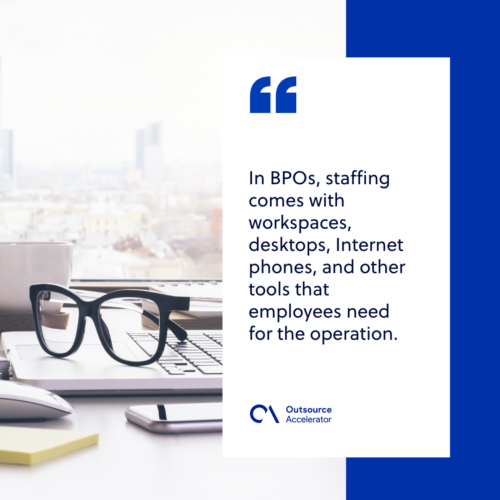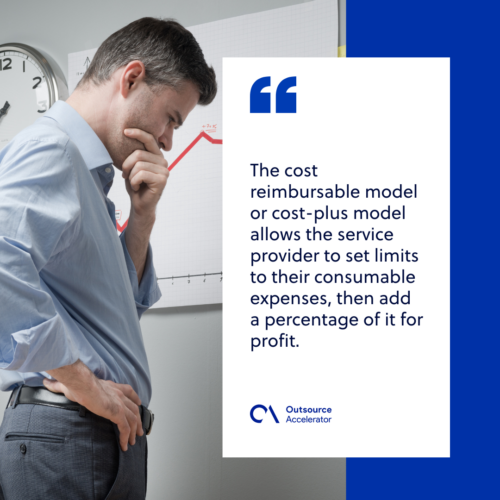8 Types of outsourcing pricing models

Business process outsourcing helps businesses control costs, scale their operation, and expand more flexibly.
Since the rise of the popularity of call centers, it has helped companies generate savings and provide better service to their customers.
This also builds a partnership between the clients and their service providers.
Currently, outsourcing not only applies to large enterprises but for small businesses as well. In fact, some startups now use this to build a distributed workforce.
Over time, the pricing structure of outsourced services changes and adapt. Below are the most common outsourcing pricing models.
Staffing model
The staffing model refers to the pricing structure where a client contract resources to a service provider for a specific period.
In BPOs, staffing comes with workspaces, desktops, Internet phones, and other tools that employees need for the operation.
The service provider and employee are usually located away from the client, either in a different city or country.
One of its advantages is that the client has control of the project. They may send an in-house employee to train and supervise their staff and scale them depending on the demand.

Fixed price (FP) model
In a fixed pricing (FP) model, a standard rate is set by the service provider for their services. This may be charged monthly or annually depending on the client’s preference and already includes charges for the tools and workspace.
FP model may also be adjusted based on several factors such as salaries, incentives, and success targets.
Fixed price adjustments
- Fixed price with economic price adjustment (FP EPA). A service provider’s pricing may be affected by adjustments on the costs of labor, materials, workspaces, and other resources included in their rate.
- For instance, salaries between junior and senior levels, upgrade of materials, and changes in the number of employees may affect this.
- Fixed price with incentive (FPI). Fixed pricing can also be combined with an incentive-based model. However, adjustments in this model are definite based on the client’s metrics.
- For instance, a sales team can receive incentive quarterly when they exceed their target quota up to 10%.
- FPI successive target (FPI ST). This model works the same as FPI. However, FPI ST lets clients adjust their target costs and profit values for the entire project.
- They usually have initial pricing at the start of their projects. Then, when they see progress in their operation, they may slowly adjust their incentives and the period when they give it.
Cost reimbursable model
The cost reimbursable model or cost-plus model allows the service provider to set limits to their consumable expenses, then add a percentage of it for profit.
This is different from the fixed price model, where they agree to a standard fee regardless of consumed expenses. With this, the service provider may or may not combine cost-plus pricing with incentive pricing.
Cost reimbursable adjustment
- Cost Plus Fixed Fee (CPFF). The client only pays a fixed fee upon project completion. The consumable cost, meanwhile, may vary for the entire project.
- Service providers get their profit from the fixed fee, so they may not need incentive charging for this model.
- Cost Plus Incentive (CPI). Unlike CPFF, CPI only adds incentives when the provider exceeds its performance for a certain period.
- This is measured based on the metrics given by the client.
- Cost Plus Award (CPA). Unlike CPI, CPA only charges clients based on the service provider’s work performance.
- This may also depend on the client’s metrics to whether the provider achieves a certain timeline, deliverable, and expectation.

Time and materials (T&M) model
Also known as cost and materials (C&M) model, time and materials (T&M) model is typical with long-term IT projects. This requires service providers to bid on a certain project and set a proposal based on the requirements of the client.
This may also be found on a build-operate-transfer (BOT) process, where the provider initially builds and manages the development of a project. T&M model also requires the provider to do its operation in-house or within the client’s supervision.
T&M variation
- T&M with cap. To control costs, the client sets a cap or upper limit on a certain project. This helps them keep an eye on the budget of their proposal and avoid excessive charges for the project.
Consumption-based pricing model
Cloud service providers, meanwhile, mostly use consumption-based pricing for their services. Here, they charge clients based on their actual usage within a month or a year. The clients, meanwhile, enjoy the flexibility of this costing since they only pay for what they use.
Examples
- Call centers allow a per-minute charging for clients expecting a low volume of calls each month.
- Cloud services, such as OneDrive and Dropbox, only charges customers for additional storage per month.
Profit-sharing pricing model
Profit-sharing model, meanwhile, may depend on the agreement between the client and service provider.
Unlike the incentive-based model, profit-sharing allows the client to allocate a percentage of their profit to the service provider.
This usually serves as a reward for a good work performance resulting to a great outcome for the client.
In profit-sharing, the client and the service provider take their partnership to a higher level.
This allows them to collaborate more and solve problems within the company and their team’s operation for a smoother workflow.
Incentive-based pricing model
On top of their usual pricing, clients may agree to send a bonus or commission to their service provider to increase their performance.
Incentive-based pricing model usually applies to seasonal accounts and extra services such as 24/7 line and after office hours service.
Example
- Outbound lead generation teams get an incentive upon exceeding their quota up to 20%.
- Sales teams receive a monthly or quarterly incentive for every successful deal closed.
Shared risk-reward pricing model
Like the incentive-based model, a shared risk-reward model also comes on top of the usual flat rate. However, the client and service provider share the risks and developments of their operation.
This can be combined with either T&M, FP, or profit-sharing models.
Gartner states that assigning responsibilities to the partner mitigates risks associated with risks such as new technologies, processes, or models.
This has become an advantage to both the provider and their clients.







 Independent
Independent




